The Canon PowerShot G7 X is one of those cameras that we have all been waiting for Canon to deliver. At the moment it was announced, there was a collective mumble of “finally” uttered among Canon enthusiasts around the world.
While Canon has attempted putting larger sensors on compact cameras (e.g., the G1 X), nothing had risen to the level of what Sony has been doing with its RX100 line of cameras. The Canon PowerShot G7 X is, in many ways, a knock-off of the Sony RX100 line. It even appears to use the same Sony 1″ sensor found in the RX100 cameras with its 20MP resolution, which is perfectly fine with me since Sony makes such a great product in the RX100 line.
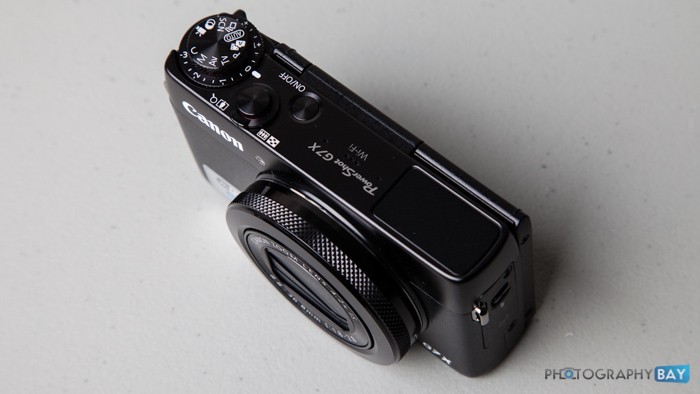
What Canon adds to the G7 X, however, is a better lens that offers a 4.2x zoom range with a max f/1.8-2.8 aperture. None of the Sony RX100 models can match that. Additionally, the G7 X delivers a bit of polish in menus and control that create the well-known Canon flavor. It works well and everything about the camera is intuitive.
Canon G7 X Key Features
- 20.2MP 1″ High-Sensitivity CMOS Sensor
- DIGIC 6 Image Processor
- 4.2x Optical Zoom f/1.8-2.8 IS Lens
- 24-100mm (35mm Equivalent)
- 3.0″ 1,040k-Dot Tilting Touchscreen LCD
- High-Speed AF with 31 Focus Points
- Full HD Video Recording at 60p
- ISO 12,800 & 6.5 fps Continuous Shooting
- Control Ring, Dials & Built-In ND Filter
- Built-In Wi-Fi Connectivity with NFC
The G7 X is an enthusiasts camera, which you can tell at first glance of the top plate controls. A handy exposure compensation dial surrounds the easy access mode dial with PASM modes available at the flick of the thumb.
The G7 X features the commonplace shutter button on top of the camera and a video record button on the back. The zoom rocker surrounding the shutter button allows you to zoom from an equivalent 24-100mm starting at f/1.8 and ending at f/2.8 max apertures. That’s quite impressive for a 1″ sensor camera.

Canon G7 X – ISO 800 – f/2.8 at 1/30s
As such, it is a great camera for indoors and low light situations. The image quality it produces is exceptional and does well even at higher ISO settings. I felt like I could shoot all day at ISO 800 without a worry. However, if you are a pixel peeper, you will certainly notice from fine grain noise.

ISO 800 – f/2.8 at 1/100s (RAW file straight out of camera)

Above image processed in Lightroom
I took the camera along with me to CES this year and used it for a lot of product shots, which in many cases were in terrible lighting. I was impressed with how well it performed in most of these circumstances.

This image of Tony Hawk at the Sony press conference was shot at ISO 500 and is a RAW file straight out of the camera, converted to JPEG for display here. Below is a 100% crop to show you what kind of noise you get with 20MP at 100%.

The 3″ LCD tilts 180-degrees for shooting selfies if that’s your thing. I found it more useful to use it while shooting lower perspectives while tilting the LCD to 90-degrees for sort of a waist-level finder feel.
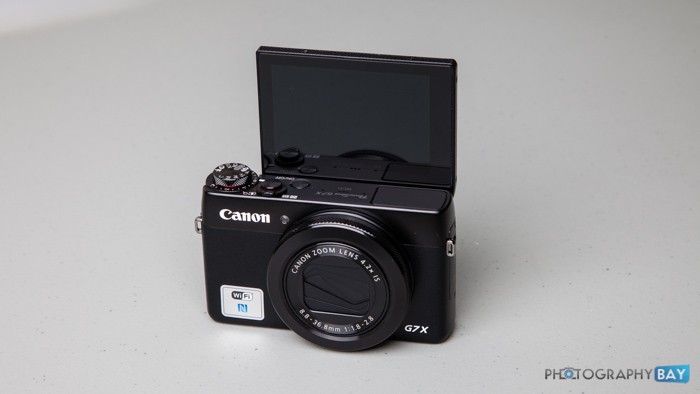
The G7 X does well with video capture too. It is when capturing video, however, that I really missed a grip on the right front of the camera. It can simply be too hard to hold sometimes. A little ridge or bump would have been welcomed there. Hopefully, the Mark II will get that upgrade. Although, there is a thumb grip on the right rear of the camera, which gives you a little tack for holding the camera with one hand.
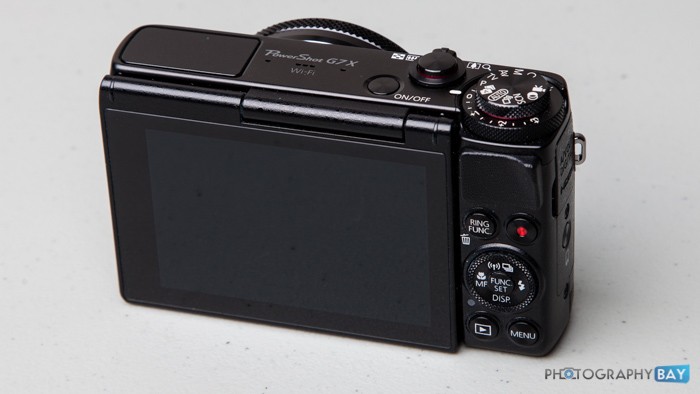
Having 1080/60p video capture is nice so you can create slow motion half-speed video if you want. That can be a nice touch to otherwise bland family video. Of course, you can also record at 30p if you want. I think this would be a great camera for vacations to serve dual purpose as a photo and video camera.
If you are going to do that though, I would suggest packing a spare battery (you’ll need the Canon NB-13L) because video capture is the thing that really seems to cut into the battery life of the G7 X. The G7 X includes a dedicated charger (some compact cameras nowadays don’t), which means you can be shooting and charging at the same time.
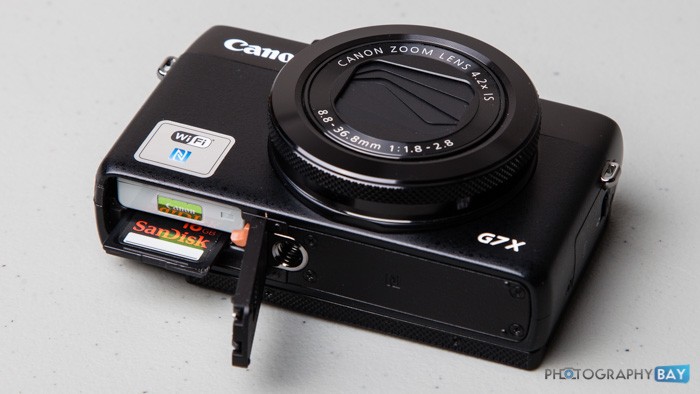
The Canon G7 X uses SD, SDHC and SDXC cards, which are inserted on the bottom of the camera next to the battery compartment. It supports UHS-I memory cards, which is an SD Association spec for Ultra High Speed bus, type 1. I don’t have a detailed breakdown on how the G7 X buffer handles files on faster cards; however, I generally recommend using a UHS-I card if a camera supports a UHS-I bus. You can find supported cards here at B&H Photo. You can also read more about memory card types, designations and speeds in my prior article Demystifying SD Cards.
Canon’s CameraWindow app and connectivity is still rather lackluster. It adds NFC for Android device connectivity. You are limited to shooting in program mode and can browse and download images to your phone. It leaves much to be desired in light of the excellent experience most phones offer with their native cameras. Canon, as well as other camera manufacturers, still have a lot of work to do to polish the wireless connectivity to smartphones.
The Canon G7 X is priced competitively with the Sony RX100 II at around $650 street today. It is a solid alternative to Sony’s RX100 models even if it is mostly a clone. The bright lens is the standout feature compared to Sony’s 28-100mm f/1.8-4.9 lens on the RX100 II and the 24-70mm f/1.8-2.8 on the RX100 III.
In a world of compact cameras dominated by smartphone cameras, the Canon G7 X is one of the few dedicated compact cameras that I would still recommend buying today.
The Canon G7 X is available from Photography Bay’s trusted retail partner, B&H Photo, at the following link:
By making your photography purchases at B&H Photo through these links, you are helping Photography Bay to continue bring quality camera tests, news and reviews. Thanks for your continued support.
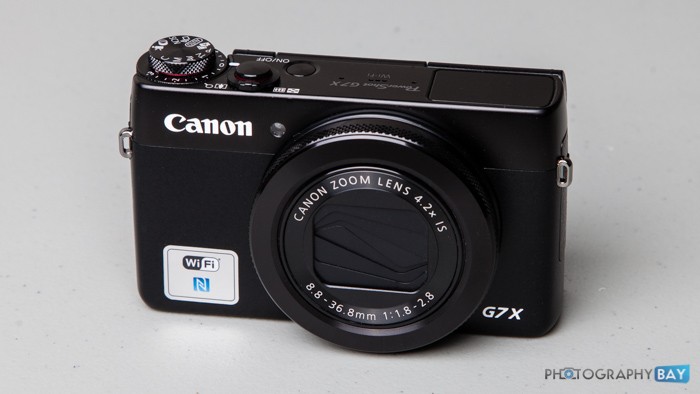
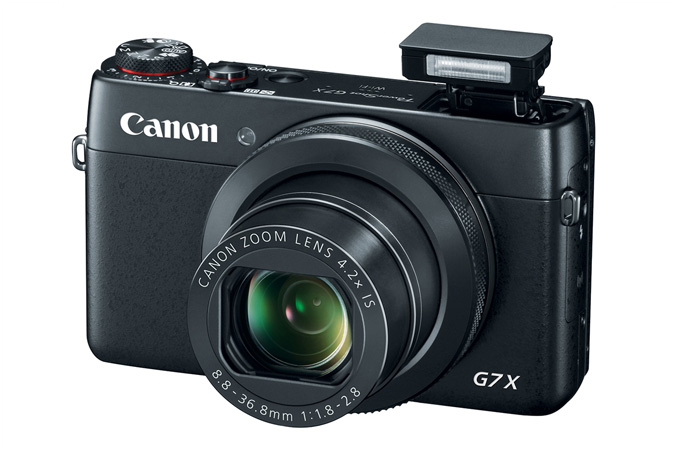


If it had a viewfinder and a hotshoe, I’d be tempted.
I thought all the other G-series included a hotshoe and viewfinder?
Sticking with my Fuji for now…
The hotshoe is a big reason you might choose the Sony RX100 II or that Panasonic LX100 over this.
Yeah, it looks like the Panasonic LX100 has everything I want: EVF and hotshoe!
Glad it has wireless and NFC, though.
Dead right, Jared. No EVF, no sale (to me). Similarly, I was waiting for the M3, hoping for an EVF, but have been disappointed there, too. An accessory EVF coming later for the M3 – adding weight and bulk and expense. Why can’t Canon get it right?
Yeah, there are times where an EVF is handy, like in bright sunlight, or in a setting like a concert/performance where you don’t want to disturb everyone around you with an obnoxious LCD screen.
Not to mention how much easier it is to hold the camera steady when it’s closer to you, rather than holding it away from your body so you can see the screen.
I picked up a Fuji X10 as a compact travel camera, for the following reasons:
– shoots raw (why would anyone NOT want this?)
– viewfinder (optical, not electronic, so it saves battery power)
– hotshoe (because pop-up flash doesn’t cut it, and I’m a Strobist)
– manual zoom lens (no battery-sucking zoom motors), just twist to zoom.
– reasonably fast lens
– oh, and I got it because of a ‘Deal Alert’ I saw here on Photography Bay (December 2013).
My ideal replacement for the little Fuji would include all of the above, and a few more things:
– NFC
– WiFi
– shoot in JPEG and DNG
As much as I prefer an optical viewfinder, I’d be OK with an EVF.
I don’t need interchangeable lenses for a compact camera. If I even start thinking about bringing extra lenses along, I’ll just use my full-frame body. A simple 24-115mm range is good enough for a compact travel camera. I’d love a constant aperture zoom, but am fine with f/2.0 – f/2.8 across the zoom range.
Eric, for sure I’m expecting you’re gonna have 5 kids by the review of the canon g7x mark2… :D :D
Haha! As much as I hate to see the little ones grow up, I think 4 is right number…
I’m with the “no EVF, no sale” crew. In addition to the factors mentioned above, it’s extremely difficult trying to track fast moving objects while holding a camera at arms length (think The Blue Angels or The Thunderbirds ). For folks like myself challenged by arthritis and/or fibromyalgia, it’s painful as well as hard to manipulate controls. For aging eyes, reading glasses are necessary to focus on the screen while EVF and optical finders have diopter correction.
I’ve been a dedicated Canon user since purchasing an F-1 in 1971, but may have to break from tradition for my next purchase.
Yes, Jeff, I too have been with Canon for a long time (AV-1, A-1, EOS 600, EOS 5 … right up to 550D and M) but I am also having doubts now. I had some very good images from the M but, having no viewfinder, it is very difficult to use in bright sunlight. Basically, I now want something that has a viewfinder, is easy to carry around, will give me superb image quality and has quiet continuous focussing in video mode. Canon could have provided the right camera by producing an M3 with a good viewfinder – but they never miss a chance to miss a chance, do they? I am wondering whether I could manage with the single fixed lens of a Fuji X100T. There may be some Canon bargains on eBay soon.